




Next: A 2D slice of
Up: Numerical examples
Previous: BP 2004 velocity benchmark
Figures ![[*]](http://sepwww.stanford.edu/latex2html/cross_ref_motif.gif) -
- ![[*]](http://sepwww.stanford.edu/latex2html/cross_ref_motif.gif) show a synthetic model for a VTI medium. Figure
show a synthetic model for a VTI medium. Figure ![[*]](http://sepwww.stanford.edu/latex2html/cross_ref_motif.gif) shows the
velocity model, Figure
shows the
velocity model, Figure ![[*]](http://sepwww.stanford.edu/latex2html/cross_ref_motif.gif) is the anisotropy parameter
is the anisotropy parameter  , and Figure
, and Figure ![[*]](http://sepwww.stanford.edu/latex2html/cross_ref_motif.gif) is the anisotropy parameter
is the anisotropy parameter  . There are 720 shots in total, and the maximum offset for each shot
is 8000 meters. The challenging part of this model is to accurately image the steep fault, salt flank and the
two abnormal sediments near the right corner of the salt body. I run plane-wave migration,
using the extrapolation operator suggested by Shan and Biondi (2005).
I generate 80 plane-wave sources, and the take-off angles at the surface range from
. There are 720 shots in total, and the maximum offset for each shot
is 8000 meters. The challenging part of this model is to accurately image the steep fault, salt flank and the
two abnormal sediments near the right corner of the salt body. I run plane-wave migration,
using the extrapolation operator suggested by Shan and Biondi (2005).
I generate 80 plane-wave sources, and the take-off angles at the surface range from  to
to  .
bprightnotilt
.
bprightnotilt
Figure 7 The image of the right salt body in Cartesian coordinates.




 bprighttilt
bprighttilt
Figure 8 The image of the right salt body in tilted coordinates.




 vpani
vpani
Figure 9 The vertical velocity model.




 epsani
epsani
Figure 10 The anisotropy parameter  .
.




 dltani
dltani
Figure 11 The anisotropy parameter  .
.




 isohesstilt
isohesstilt
Figure 12 Isotropic migration in tilted coordinates.




 anihessnotilt
anihessnotilt
Figure 13 Anisotropic migration in Cartesian coordinates.




 anihesstilt
anihesstilt
Figure 14 Anisotropic migration in tilted coordinates.




 anihesstilteps
anihesstilteps
Figure 15 Anisotropic migration in tilted coordinates overlaid with the model.





Figure ![[*]](http://sepwww.stanford.edu/latex2html/cross_ref_motif.gif) is the image obtained by isotropic plane-wave migration in tilted coordinates. Though
we can see the energy of steeply dipping reflectors like the salt flanks and fault, they are not at the correct
positions. Figure
is the image obtained by isotropic plane-wave migration in tilted coordinates. Though
we can see the energy of steeply dipping reflectors like the salt flanks and fault, they are not at the correct
positions. Figure ![[*]](http://sepwww.stanford.edu/latex2html/cross_ref_motif.gif) is the image obtained by anisotropic plane-wave migration in Cartesian
coordinates. The reflectors are at the right positions, but some parts of the steeply dipping salt flank are lost, and
the bottom of the fault is not well focused. Also the bottom abnormal sediment at the right corner of the salt body
loses its energy where it is close to the salt. Figure
is the image obtained by anisotropic plane-wave migration in Cartesian
coordinates. The reflectors are at the right positions, but some parts of the steeply dipping salt flank are lost, and
the bottom of the fault is not well focused. Also the bottom abnormal sediment at the right corner of the salt body
loses its energy where it is close to the salt. Figure ![[*]](http://sepwww.stanford.edu/latex2html/cross_ref_motif.gif) is the image obtained by anisotropic plane-wave
migration in tilted coordinates. In Figure
is the image obtained by anisotropic plane-wave
migration in tilted coordinates. In Figure ![[*]](http://sepwww.stanford.edu/latex2html/cross_ref_motif.gif) , the salt flanks, the fault and
abnormal sediments are all well imaged. Figure
, the salt flanks, the fault and
abnormal sediments are all well imaged. Figure ![[*]](http://sepwww.stanford.edu/latex2html/cross_ref_motif.gif) overlays the image by anisotropic plane-wave
migration in tilted coordinates with the actual model, and shows that the reflectors are imaged at
the correction positions.
overlays the image by anisotropic plane-wave
migration in tilted coordinates with the actual model, and shows that the reflectors are imaged at
the correction positions.





Next: A 2D slice of
Up: Numerical examples
Previous: BP 2004 velocity benchmark
Stanford Exploration Project
4/5/2006
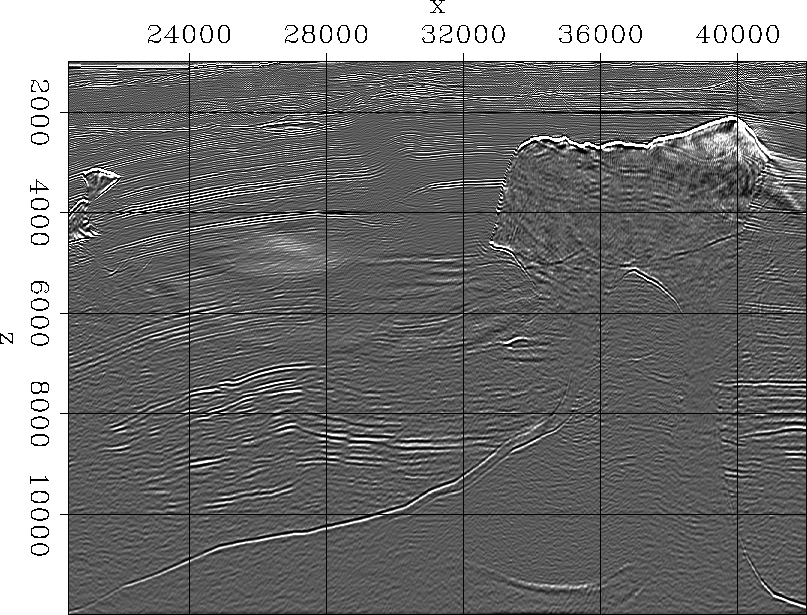
![[*]](http://sepwww.stanford.edu/latex2html/cross_ref_motif.gif) -
- ![[*]](http://sepwww.stanford.edu/latex2html/cross_ref_motif.gif) show a synthetic model for a VTI medium. Figure
show a synthetic model for a VTI medium. Figure ![[*]](http://sepwww.stanford.edu/latex2html/cross_ref_motif.gif) shows the
velocity model, Figure
shows the
velocity model, Figure ![[*]](http://sepwww.stanford.edu/latex2html/cross_ref_motif.gif) is the anisotropy parameter
is the anisotropy parameter ![[*]](http://sepwww.stanford.edu/latex2html/cross_ref_motif.gif) is the anisotropy parameter
is the anisotropy parameter 
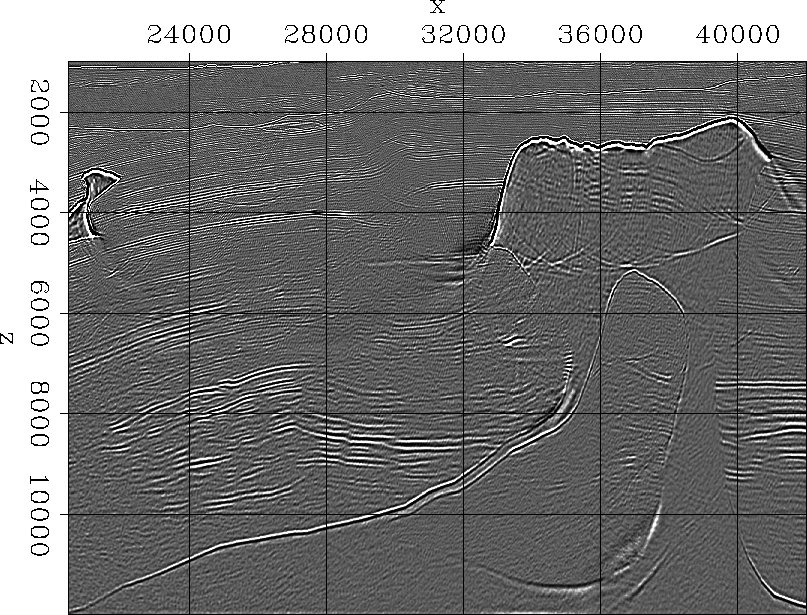
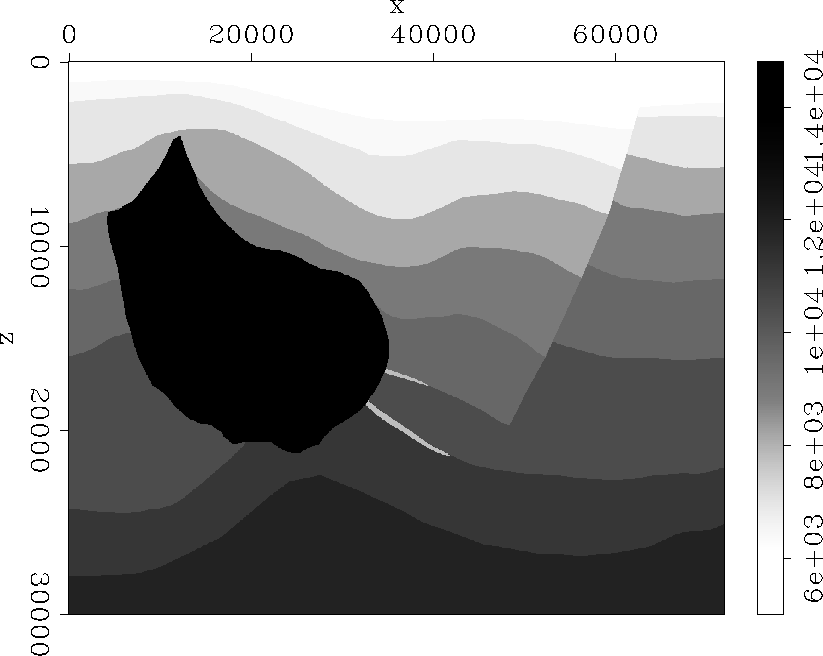

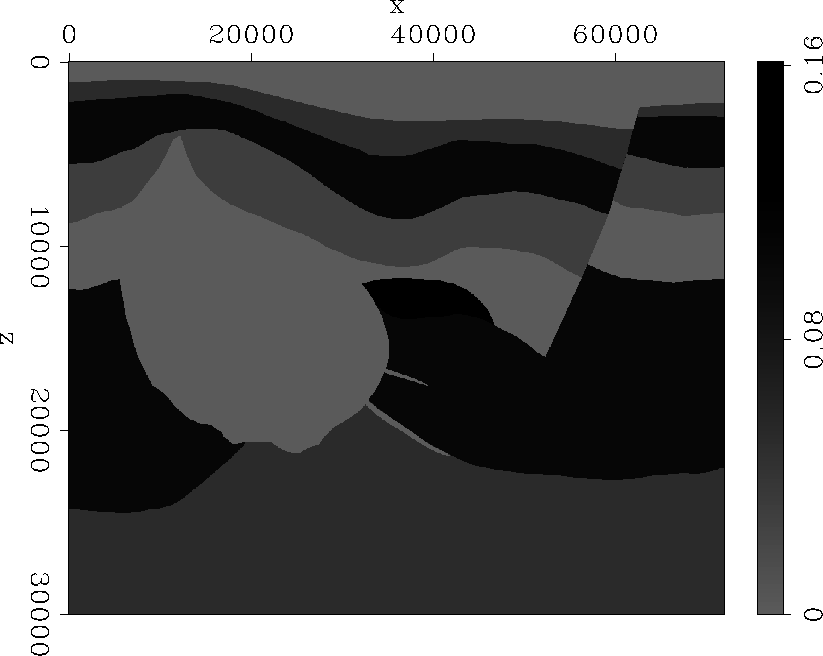
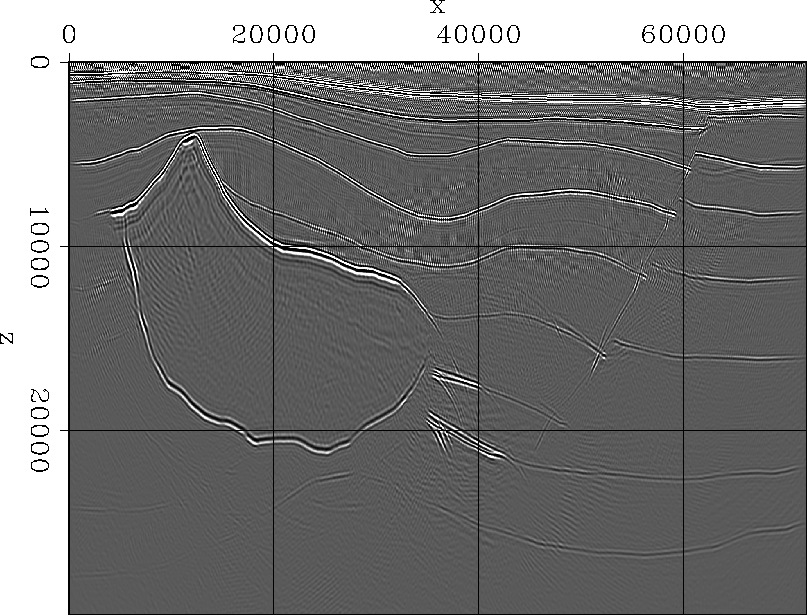
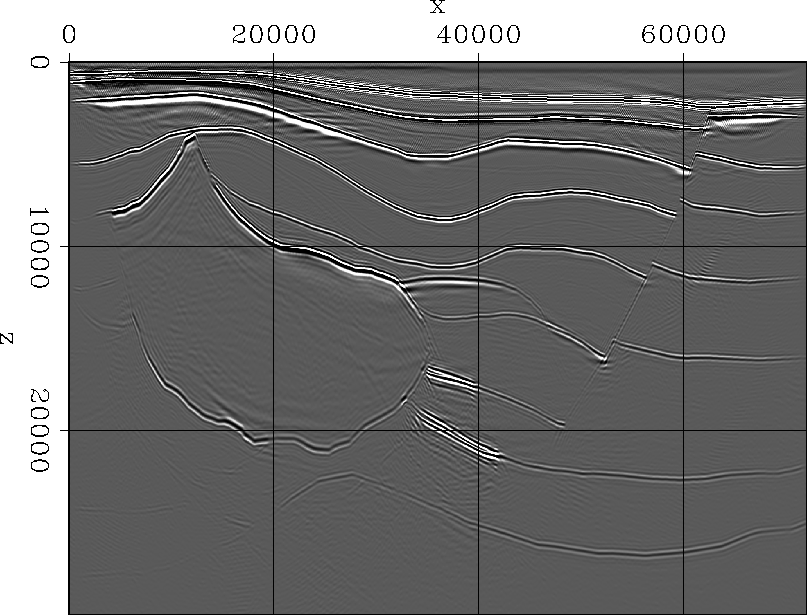
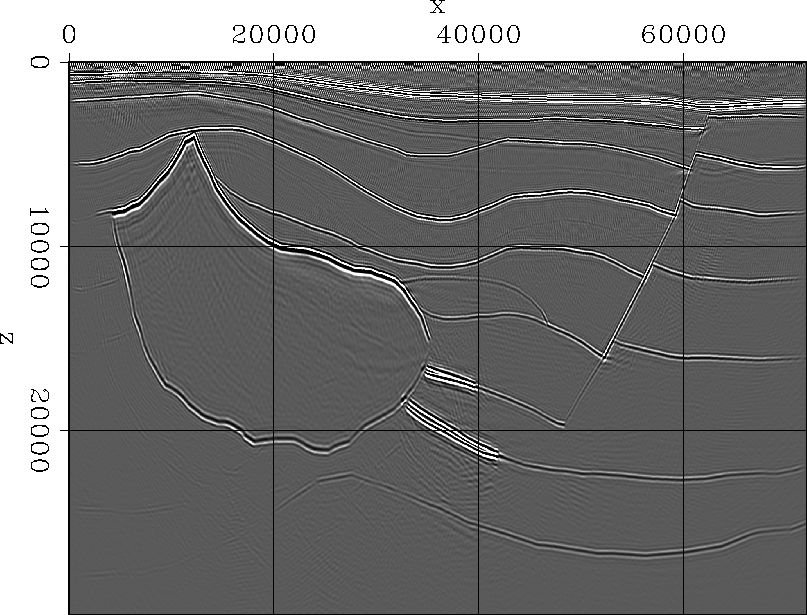
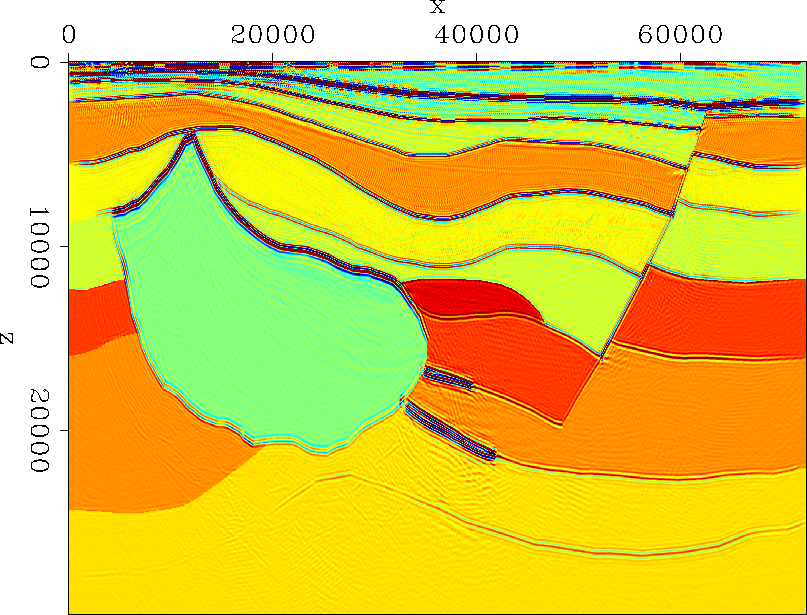
![[*]](http://sepwww.stanford.edu/latex2html/cross_ref_motif.gif) is the image obtained by isotropic plane-wave migration in tilted coordinates. Though
we can see the energy of steeply dipping reflectors like the salt flanks and fault, they are not at the correct
positions. Figure
is the image obtained by isotropic plane-wave migration in tilted coordinates. Though
we can see the energy of steeply dipping reflectors like the salt flanks and fault, they are not at the correct
positions. Figure ![[*]](http://sepwww.stanford.edu/latex2html/cross_ref_motif.gif) is the image obtained by anisotropic plane-wave migration in Cartesian
coordinates. The reflectors are at the right positions, but some parts of the steeply dipping salt flank are lost, and
the bottom of the fault is not well focused. Also the bottom abnormal sediment at the right corner of the salt body
loses its energy where it is close to the salt. Figure
is the image obtained by anisotropic plane-wave migration in Cartesian
coordinates. The reflectors are at the right positions, but some parts of the steeply dipping salt flank are lost, and
the bottom of the fault is not well focused. Also the bottom abnormal sediment at the right corner of the salt body
loses its energy where it is close to the salt. Figure ![[*]](http://sepwww.stanford.edu/latex2html/cross_ref_motif.gif) is the image obtained by anisotropic plane-wave
migration in tilted coordinates. In Figure
is the image obtained by anisotropic plane-wave
migration in tilted coordinates. In Figure ![[*]](http://sepwww.stanford.edu/latex2html/cross_ref_motif.gif) , the salt flanks, the fault and
abnormal sediments are all well imaged. Figure
, the salt flanks, the fault and
abnormal sediments are all well imaged. Figure ![[*]](http://sepwww.stanford.edu/latex2html/cross_ref_motif.gif) overlays the image by anisotropic plane-wave
migration in tilted coordinates with the actual model, and shows that the reflectors are imaged at
the correction positions.
overlays the image by anisotropic plane-wave
migration in tilted coordinates with the actual model, and shows that the reflectors are imaged at
the correction positions.